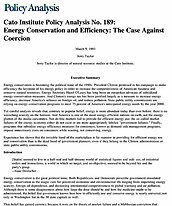Yet careful analysis reveals that, contrary to popular belief, energy is more abundant today than ever before; there is no wrenching scarcity on the horizon. And America is one of the most energy-efficient nations on earth, not the energy glutton of the media caricatures. Nor do free markets fail to provide for efficient energy use; the so-called market failures of the energy economy either do not exist or are more appropriately labeled “government failures.” Finally, programs that subsidize energy-efficiency measures for consumers, known as demand-side management programs, impose unnecessary costs on consumers while wasting, not conserving, energy.
Experience has shown that the invisible hand of the marketplace is far superior in providing for efficient energy use and conservation than is the dead hand of government planners, even if they belong to the Clinton administration or state public utility commissions.


